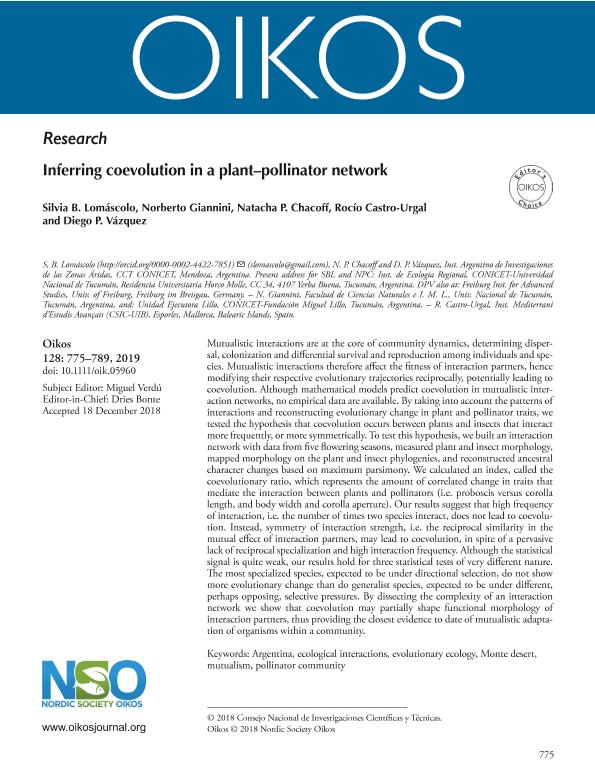Mostrar el registro sencillo del ítem
dc.contributor.author
Lomascolo, Silvia Beatriz

dc.contributor.author
Giannini, Norberto Pedro

dc.contributor.author
Chacoff, Natacha Paola

dc.contributor.author
Castro Urgal, Rocío
dc.contributor.author
Vazquez, Diego P.

dc.date.available
2020-11-27T17:49:14Z
dc.date.issued
2018-12
dc.identifier.citation
Lomascolo, Silvia Beatriz; Giannini, Norberto Pedro; Chacoff, Natacha Paola; Castro Urgal, Rocío; Vazquez, Diego P.; Inferring coevolution in a plant–pollinator network; Wiley Blackwell Publishing, Inc; Oikos; 128; 6; 12-2018; 775-789
dc.identifier.issn
0030-1299
dc.identifier.uri
http://hdl.handle.net/11336/119258
dc.description.abstract
Mutualistic interactions are at the core of community dynamics, determining dispersal, colonization and differential survival and reproduction among individuals and species. Mutualistic interactions therefore affect the fitness of interaction partners, hence modifying their respective evolutionary trajectories reciprocally, potentially leading to coevolution. Although mathematical models predict coevolution in mutualistic interaction networks, no empirical data are available. By taking into account the patterns of interactions and reconstructing evolutionary change in plant and pollinator traits, we tested the hypothesis that coevolution occurs between plants and insects that interact more frequently, or more symmetrically. To test this hypothesis, we built an interaction network with data from five flowering seasons, measured plant and insect morphology, mapped morphology on the plant and insect phylogenies, and reconstructed ancestral character changes based on maximum parsimony. We calculated an index, called the coevolutionary ratio, which represents the amount of correlated change in traits that mediate the interaction between plants and pollinators (i.e. proboscis versus corolla length, and body width and corolla aperture). Our results suggest that high frequency of interaction, i.e. the number of times two species interact, does not lead to coevolution. Instead, symmetry of interaction strength, i.e. the reciprocal similarity in the mutual effect of interaction partners, may lead to coevolution, in spite of a pervasive lack of reciprocal specialization and high interaction frequency. Although the statistical signal is quite weak, our results hold for three statistical tests of very different nature. The most specialized species, expected to be under directional selection, do not show more evolutionary change than do generalist species, expected to be under different, perhaps opposing, selective pressures. By dissecting the complexity of an interaction network we show that coevolution may partially shape functional morphology of interaction partners, thus providing the closest evidence to date of mutualistic adaptation of organisms within a community.
dc.format
application/pdf
dc.language.iso
eng
dc.publisher
Wiley Blackwell Publishing, Inc

dc.rights
info:eu-repo/semantics/openAccess
dc.rights.uri
https://creativecommons.org/licenses/by-nc-sa/2.5/ar/
dc.subject
ARGENTINA
dc.subject
ECOLOGICAL INTERACTIONS
dc.subject
EVOLUTIONARY ECOLOGY
dc.subject
MONTE DESERT
dc.subject
MUTUALISM
dc.subject
POLLINATOR COMMUNITY
dc.subject.classification
Ecología

dc.subject.classification
Ciencias Biológicas

dc.subject.classification
CIENCIAS NATURALES Y EXACTAS

dc.title
Inferring coevolution in a plant–pollinator network
dc.type
info:eu-repo/semantics/article
dc.type
info:ar-repo/semantics/artículo
dc.type
info:eu-repo/semantics/publishedVersion
dc.date.updated
2020-11-20T18:09:54Z
dc.journal.volume
128
dc.journal.number
6
dc.journal.pagination
775-789
dc.journal.pais
Reino Unido

dc.journal.ciudad
Londres
dc.description.fil
Fil: Lomascolo, Silvia Beatriz. Consejo Nacional de Investigaciones Científicas y Técnicas. Centro Científico Tecnológico Conicet - Mendoza. Instituto Argentino de Investigaciones de las Zonas Áridas. Provincia de Mendoza. Instituto Argentino de Investigaciones de las Zonas Áridas. Universidad Nacional de Cuyo. Instituto Argentino de Investigaciones de las Zonas Áridas; Argentina
dc.description.fil
Fil: Giannini, Norberto Pedro. Consejo Nacional de Investigaciones Científicas y Técnicas. Centro Científico Tecnológico - Tucumán. Unidad Ejecutora Lillo; Argentina
dc.description.fil
Fil: Chacoff, Natacha Paola. Consejo Nacional de Investigaciones Científicas y Técnicas. Centro Científico Tecnológico Conicet - Mendoza. Instituto Argentino de Investigaciones de las Zonas Áridas. Provincia de Mendoza. Instituto Argentino de Investigaciones de las Zonas Áridas. Universidad Nacional de Cuyo. Instituto Argentino de Investigaciones de las Zonas Áridas; Argentina
dc.description.fil
Fil: Castro Urgal, Rocío. Universidad Nacional de Tucumán; Argentina. Inst. Mediterrani d’Estudis Avançats; España
dc.description.fil
Fil: Vazquez, Diego P.. Consejo Nacional de Investigaciones Científicas y Técnicas. Centro Científico Tecnológico Conicet - Mendoza. Instituto Argentino de Investigaciones de las Zonas Áridas. Provincia de Mendoza. Instituto Argentino de Investigaciones de las Zonas Áridas. Universidad Nacional de Cuyo. Instituto Argentino de Investigaciones de las Zonas Áridas; Argentina
dc.journal.title
Oikos

dc.relation.alternativeid
info:eu-repo/semantics/altIdentifier/doi/http://dx.doi.org/10.1111/oik.05960
dc.relation.alternativeid
info:eu-repo/semantics/altIdentifier/url/https://onlinelibrary.wiley.com/doi/abs/10.1111/oik.05960
Archivos asociados
